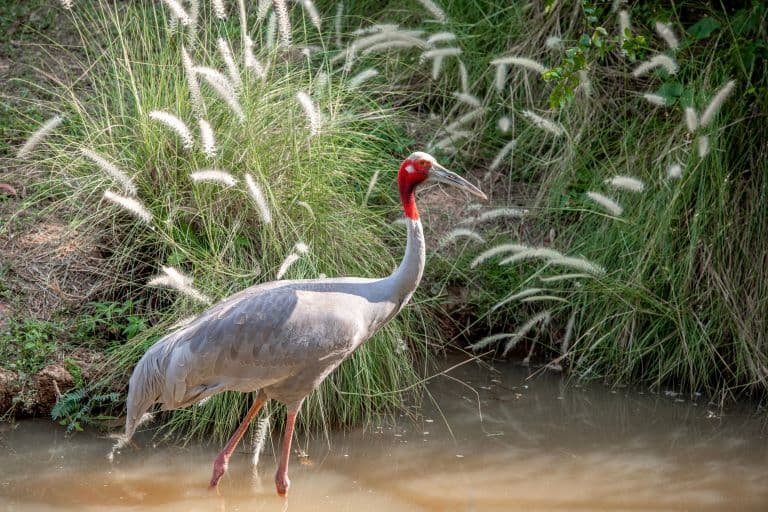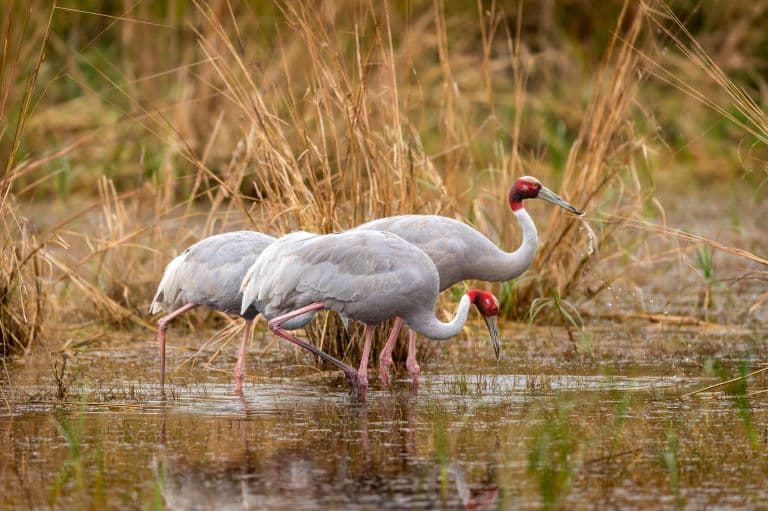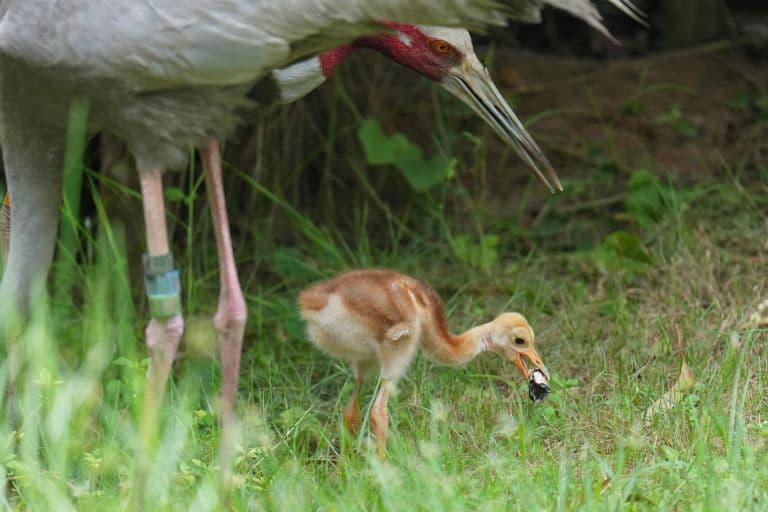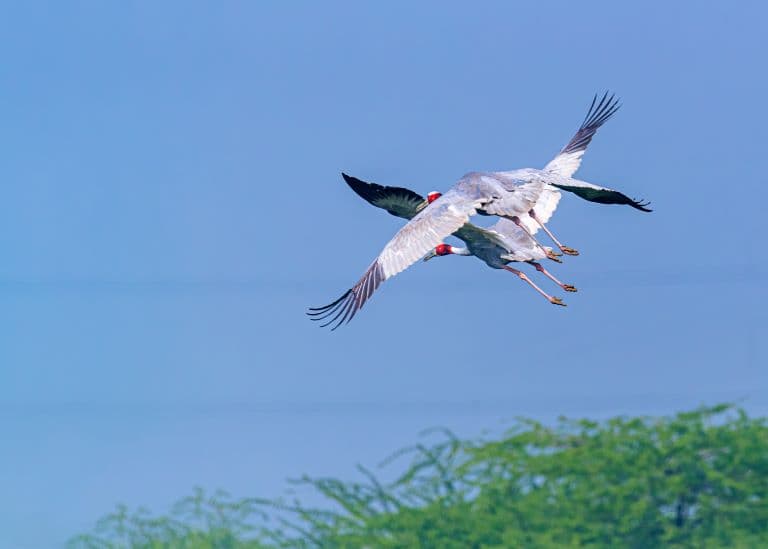Sarus Crane Profile
In India, there’s a bird so historically revered that they have inspired diverse creations from poetry to architecture, is considered sacred among the Gondi people, and its meat is taboo in Hindu scriptures.
These are the Sarus cranes and the tallest flying birds. Unfortunately, colonials had no such respect for them and hunted them without shame.
Today, while still protected and hunted much less, their major threats are from habitat destruction from local farming practices.

Sarus Crane Facts Overview
| Habitat: | Open wetlands, forests, grasslands |
| Location: | India, Southeast Asia, Australia |
| Lifespan: | 42 + years |
| Size: | 1.8 m (5 ft 11 in) tall |
| Weight: | Up to 12 kg (26 lb) |
| Colour: | Grey, with a white throat, red face and pink legs |
| Diet: | Insects, plants, fish, frogs, crustaceans, seeds, sometimes young birds |
| Predators: | Adults have no predators but crows attack nests, dingoes eat young |
| Top Speed: | Slow |
| No. of Species: | 1 |
| Conservation Status: | Vulnerable (IUCN) |
The Sarus crane is a bird with seriously long legs. It stands taller than most people, and far humbler. They rarely hang out with one another but come together on occasion to dance and mate.
These opportunistic omnivores are so graceful they’ve cemented themselves into the ancient cultures of the people living around them, but unfortunately, as their neighbours hurtle towards modernity, the global habitat devastation threatens to end this relationship.
Interesting Sarus Crane Facts
1. They’re tall
Cranes and storks are well known for their long legs, but even the largest flying storks such as the Marabou only stand around 1.5 metres tall.
Sarus cranes aren’t as bulky or enormous as Marabous, but they are taller. They have a more elegant and slender build, and the legs to go with it. Many reach around 1.8 metres, or 5 ft 11 inches in height, significantly taller than the world average for humans! 1

2. They’re not social
Having the legs of a supermodel apparently comes with a bit of the attitude too, and these tall redheads are considered to be the least social of all the cranes.
Unfortunately for anti-social animals, most of them still have to tolerate one another when they want to reproduce, so these cranes will be found in pairs during mating season. But while nesting they’re very stand-offish towards other animals in their area, and will fiercely protect their eggs.
They also benefit from safety in numbers and will form flocks and roost in groups, but they won’t enjoy it, and they definitely don’t seem to like one another.
3. But they do like to dance
When hormones outweigh principles, two cranes will engage in a ritual mating ceremony. Cranes are quite well known for their dancing, and the Sarus doesn’t let the team down here.
Mating dances come with the characteristic trumpeting sounds that cranes are often heard making, and lots of hopping, flapping and head bobbing. 2
4. They’re not fussy eaters
These cranes are omnivorous, as are most in the order, and this makes them very adaptable as long as a healthy habitat is available.
Sarus cranes eat insects, aquatic plants, fish, frogs, seeds, and even water snakes, and turtles. They’ll occasionally eat other birds’ eggs.
Of the plant matter they eat, it appears to be tubers and grass shoots that are a favourite, and out of all the insects around, they seem to have a penchant for grasshoppers.
That is if they’re in wild ecosystems. If they’re around farmland, their opportunistic feeding habits can become a bit of a problem.

5. They can be a pest
In a lot of their range, sarus cranes have access to wet agricultural areas such as rice paddies and wheat fields. These artificial habitats have plenty of amphibians and other aquatic vertebrates, but the cranes will also feed on the crops.
Grains, beans, cucumbers and rice are all good food for this bird, and this can bring them into conflict with farmers.
6. They bond strongly
There are several reasons the Sarus crane is venerated in India. Its grace and elegance make it an appealing bird to look at, but its personality has inspired respect, too.
This species is thought to pair for life, and this might be in the literal sense because local knowledge suggests that if one is killed, its partner will starve to death from grief. Whether or not this is true, records suggest that the remaining crane will sorrowfully call out for many days.
This symbol of fidelity is why in Gujurat, it’s common to take newlyweds to see a pair of these birds, to remind them that they are now mortally linked and probably should have reconsidered.

7. Even to people
It’s not only other cranes that are the focus of such powerful bonds; when raised by hand they become incredibly tame and loyal to their human companions too.
They’ll dance and play and generally bring a lot of colour to a menagerie, though will maintain their territorial aggression towards strangers, including other animals like dogs.
8. They’re vulnerable
Unfortunately, despite their versatility, this species is in decline.
Wetlands are often overlooked as viable habitats because they rarely provide much that humans use, so they are routinely drained and built upon, or modified into agricultural land, both of which are now cutting into the space the cranes need to thrive.
Hunting still occurs too, and is slowly rising in places where the animal used to be sacred. It’s also possible that increased urbanisation is bringing more species that thrive in such spaces like crows, jackals, and rats; and these are all threats to the eggs of Sarus cranes.
As of now, they’re listed as Vulnerable by the IUCN, and decreasing in number. 3
Sarus Crane Fact-File Summary
Scientific Classification
| Kingdom: | Animalia |
| Phylum: | Chordata |
| Class: | Aves |
| Order: | Gruiformes |
| Family: | Gruidae |
| Genus: | Antigone |
| Species: | antigone |
Fact Sources & References
- “Grus antigone Sarus crane”, Animal Diversity Web.
- DiscoverWildIndia (2018), “Dance Of The Sarus | World’s Tallest Flying Bird | State Bird Uttar Pradesh | India’s Tallest Bird”, YouTube.
- “Sarus Crane”, IUCN Red List.
